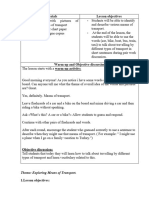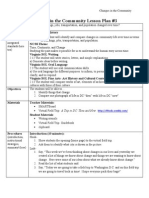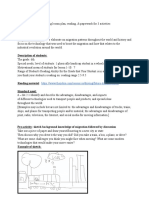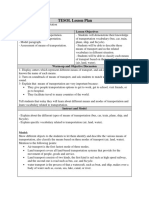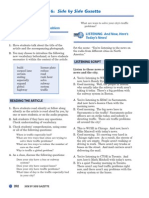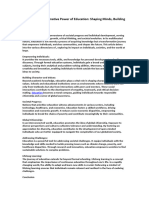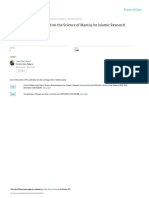0 ratings0% found this document useful (0 votes)
739 viewsTransportation Then and Now
Transportation Then and Now
Uploaded by
api-242330122Copyright:
© All Rights Reserved
Available Formats
Download as DOCX, PDF, TXT or read online from Scribd
Transportation Then and Now
Transportation Then and Now
Uploaded by
api-2423301220 ratings0% found this document useful (0 votes)
739 views12 pagesOriginal Title
transportation then and now
Copyright
© © All Rights Reserved
Available Formats
DOCX, PDF, TXT or read online from Scribd
Share this document
Did you find this document useful?
Is this content inappropriate?
Copyright:
© All Rights Reserved
Available Formats
Download as DOCX, PDF, TXT or read online from Scribd
Download as docx, pdf, or txt
0 ratings0% found this document useful (0 votes)
739 views12 pagesTransportation Then and Now
Transportation Then and Now
Uploaded by
api-242330122Copyright:
© All Rights Reserved
Available Formats
Download as DOCX, PDF, TXT or read online from Scribd
Download as docx, pdf, or txt
You are on page 1of 12
1
Spring Arbor University School of Education
Lesson Plan Guide
Title of Lesson: Transportation Then and Now Teacher Candidates:
Jenni Dyke
Enduring Understanding: Know history of transportation.
Essential Question: What are the important historical events of transportation in history?
Subject(s): Social Studies
Grade Level: First Time Allotted: 45 minutes
Materials Required:
Pictures of modes of transportation
Modes of transportation power point
Old and new signs
Double bubble chart
Writing utensils
Foldable made by the teacher
Whiteboard & markers
Elmo & projector
_____________________________________________________________________________________
Common Core Standard: (Number and narrative)
- Reading Standard K-5 Grade 1 Number 3
Describe the connection between two individuals, events, ideas, or pieces of information in a text
GLCE:
- 1-H2.0.6: Compare life today with life in the past using the criteria of family, school, or
communication
Objectives: The student will {Blooms taxonomy verb} {level of Blooms taxonomy learning)
1. TLW write information about the different types of transportation so they have at least one piece of
information about old and new technology for each mode of representation on their foldable.
(Application)
2. TLW compare transportation today with transportation in the past by completing a double bubble chart
with at least 3 facts listed correct.
(Analysis)
Student Friendly Objectives:
The leaner will write information about each mode of transportation including old and new on their
foldable.
The learner will compare transportation today with transportation in the past using a double bubble chart.
2
Purpose of the lesson: The students should build on their knowledge of the history of transportation and
how it compares to todays transportation.
____________________________________________________________________________________
Instructional Procedure: What information do students need to accomplish the objective?
Time
Allotted
Essential Elements
7
minutes
1. Anticipatory Set:
First, have the students draw from their past knowledge. Ask critical
questions to spark students thinking such as How do you think students got to school
before there were cars or busses? Did it take longer back then or now? Mention
that thanks to Henry Ford and his Model-T, we do not always have to walk or ride our
bikes to school every day. We can ride in a car or take the bus. Show the students a
picture of Henry Ford and his Model-T. We will ask student for comments when we
show them the picture of Henry Ford.
Our rules for our time together today are for students to pay attention, follow
directions, dont talk during instruction, and try to stay in their seats.
Today, we are going to continue talking about transportation like we know
you have already been doing in class. Can anyone tell me what transportation is?
Great! To start we want to see what you already know about transportation. We are
going to think about how transportation in the past is different than today. How do
you think students got to school before there were cars? Did it take longer before
there were cars or busses? The man who made the first car was Henry Ford and
thanks to him we no longer have to walk, ride bikes, or take a horse wherever we go.
Throughout this lesson we will talk about more types of transportation and
compare how we use them today and how they were used in the past. For our time
3
today, students, I expect all of you to pay attention, follow the directions I give you,
and that you stay quietly in your seats unless told otherwise. Also, please do not talk
during instructions so that you know what you need to do.
2
minutes
1. State Purpose and Objective(s) of Lesson:
The students will learn about different kinds of transportation in the past and
how it compares to transportation today. This is important to learn because without
the transportation in the past transportation today would not be the same.
The reason I have started today with a conversation on transportation with
Henry Ford is because when he created the Model T he changed transportation
forever! (show picture) During todays lesson you will learn that without the
transportation of the past the types of transportation you use today would not be the
same.
Our goal is for you to understand the different kinds of transportation and
how transportation today compares to transportation of the past. It is also important
for you to understand that there are different types of transportation, cars, boats,
trains, and planes. Another purpose of this lesson is to help you be able to tell the
difference between these types of transportation, for example planes fly, and cars
drive, boats float, and trains follow tracks.
Our objectives for todays lesson are as follow, you the students will match the
connections between various types of transportation, as well as compare
transportation today with transportation of the past.
2. Instructional Input Plan:
a. Modeling:
Today as I am telling you the information about the different kinds of
transportation I want you to complete this foldable. The cover has the different types
4
25
minutes
of transportation we are going to be looking at: cars, planes, trains, and boats. If you
open each flap you can see one side says old and the other says new for each type of
transportation. You should write at least one thing you hear in each spot. I will help
you or slow down if you need it.
Lets talk about cars for a little bit. Cars of the past were made with
wooden wheels, few windshields if any at all, and no seat belts or airbags. The
Model T came in one color and that was black. Another interesting fact is that
the Model T used oil lamps and was priced at $850. The Model T had a top
speed of 35-40 miles per hour and did not have a rearview mirror.
Cars of today have air bags and seat belts to protect the passengers.
Cars also come in a variety of colors and a variety of sizes. Cars today also
have rearview mirrors and can exceed speeds of 100 miles per hour. Cars
today are also capable of running on electricity and other types of fuel different
than gas. Thanks to the creation of the Model T we now have trucks and other
vehicles that use wheels powered by engines.
Although there are a lot of differences between cars of the past and the
cars we use today, there are still similarities such as being powered by gas and
cars from both time periods are designed to make traveling easier.
Now we will move on to boats. (show pictures) Boats have not
always been cruise ships and speed boats; they have been around for hundreds
of years and have many things that are different, but also many things that
stayed the same. Boats of the past didnt have motors and they required wind
to move their sails or people rowing their oars. Boats used to take months to
5
cross the ocean and they did this without any GPS or digital technology. Ships
use to be primarily used for exploration, finding resources and fishing but now
they are used for vacation cruise ships. Boats and ships of the past were often
made of wooden materials.
Boats of today typically have motors, are made of stronger materials like
metal, and are able to carry more people. Boats today can travel further faster and
are safer than ships built in the past. Boats and ships today are larger and can carry
planes and helicopters. Large boats called freights often carry merchandise and food
and deliver them to countries all around the world.
With all those things different there are still some boats that are made of
wood like they use to be. As, as you might have guessed all boats still move in the
water. They also still move things from one spot to another, whether that is across the
ocean, or around the lake to go tubing.
Trains (show pictures) are another thing that has changed greatly over the
years. The first train was built over 200 years ago and needed steam made from
burning things like coal. Do you know what coal is? Here is something similar to
coal (show charcoal) It is charcoal. Coal is a type of rock that people use to make
heat, which is how they made the trains move. These trains had to run on tracks. The
first tracks were made out of wood, but now they are made out of things like iron. At
first trains were made to carry just materials with the only people on the train being
the workers.
Today trains are a lot different they can go a lot faster, there are trains made
just for people to ride, and some trains can go above or below the ground. Trains that
we see today do not all need to run on coal anymore, they can be different things like
electricity. Although there are many differences between trains today and years ago,
6
they still run on tracks, they still can carry people and materials, and there are many
that run on the ground.
Finally, lets talk about airplanes. (show pictures) As you can see,
airplanes in the past were a lot different than airplanes today. The first airplanes
made were gliders. That means they had no engines in them. Also, they were made
mostly of wood and had propellers. The first airplane to have a person in it only
stayed in the air for about twelve seconds.
Today, airplanes are much safer and improved. (show pictures) They are
made of metal and can hold many passengers. They have a more powerful engine that
can fly for hours at a time. Jet engines help the airplanes fly higher than many clouds
even do. Also, they have a covered seating area so the passengers arent out in the
wind.
Even though airplanes in the past are different from what we have today, there
are still a couple ways that they are the same. As you probably know, airplanes fly
only in the air. They are the only mode of transportation we talked about today that
can do that. One of the most important things that stayed the same is the need for a
pilot. Pilots are the ones that fly the airplanes and make sure they can get from one
place to another.
b. Guided Practice:
To practice what the students have learned, we will do another group activity.
I will show the students more pictures of both old and new modes of transportation
and have them decide which category they fit in best. I can use the pictures from the
slide show I addressed during modeling. I will monitor their answers by having the
students hold up a sign that either says old or new to let us know what they think.
For this activity I will show you a picture of a certain type of transportation.
7
Your job will to be figure out if it is an older type of transportation or something new
that you might see today. If it is old you will take the paper that I gave you that says,
old and raise it in the air so that I can read it. If you think it is new, than raise the
paper I gave you that says, new. Lets try a practice one. If I raise this picture (a
picture of a modern car) show me what paper you would raise in the air. Right a lot
of the class raised the paper that says new, since this is a car like we use today.
Now we are going to go through the rest of the pictures.
c. I ndependent Practice:
For this activity, we will be using a double bubble chart. The students should
have already used this in class so they are familiar with this strategy. To demonstrate
what I would like the students to do, I will write one fact on the bubble chart and show
it on the Elmo. They will need to decide on their own which of the remaining facts go
on which side of the chart and also which ones are shared by both the old and new
forms of the mode. They will fill in the rest of the bubbles on their own as further
practice of what they have learned. They may use their foldable to help them with the
information.
Now that you have learned all about these different kinds of transportation,
its time to practice. Each of you has been given a double bubble chart that looks like
this (show chart.) This will be used to compare an old and a new form of
transportation.
I am going to fill in a few bubbles with you to show you how to do it, and then
I want you to do the rest on your own. (Call on a child) Pick a fact from your
foldable. Ok, class, where do you think that fact would go? On the new side, the
old side, or the bubbles in the middle? Right! Lets do one for each section. Can
you find a new fact? Now can you identify a fact that both old and new
8
share? Great! Now using the rest of the facts, fill in the bubble chart the best you
can. Feel free to ask any of us for help as you work.
3. Differentiation Considerations (accommodations):
If students happen to have trouble with the independent practice (the double
bubble chart) we will go over it as a class using the Elmo. This will hopefully take
away any stress they are feeling and make things easier for them while still getting in
the needed practice.
Are you having trouble with your bubble charts? Ok, how about we go over
it as a class. Does that sound better? Great.
If some of the students who finish early, I will have them try to write extra
characteristics that they come up with on the side of the chart.
Wow! Great job with your bubble chart! Since you finished a little faster
than the other students, would you write a few extra facts on the side? You can draw
extra bubbles or just write them on the side you think they should be on if you would
like. Thank you!
4. Assessment:
Informal Formative This is done in the guided practice when the students
hold up signs to tell if the picture is old or new mode of transportation. The
students are not being graded, but the teacher can use it to see what they
know.
Informal Summative The foldable notes is something that should benefit the
students learning that will not be graded. The students can have help filling it
out and can use it when they complete their double bubble chart.
Formal Summative The double bubble chart is what the teacher is collecting
at the end of class. This shows if the student can compare the modes of
9
transportation now to the past.
3
minutes
5. Closure:
At the end of our lesson, I will do a short, verbal assessment. I will have the students
verbally express a few examples of characteristics they have learned. I will keep
asking for examples until we have one from each category.
Can any of you bright first graders raise your hand and tell me four
different types of transportation? Great job now I would like someone to tell me
something that use to be true about cars in the past but has changed? Great job, can
someone else tell me something about planes today and whats makes them different
than planes in the past? Next I would like to know if anyone could tell me the
difference between the first trains and trains you may see today. For my last question
can someone raise a quiet hand and tell me one thing you learned about boats, and
rather what you learned is a characteristic of the past or present type of
transportation?
Great job class, thank you for your participation in our lesson.
10
OLD
NEW
11
cars
Air bags and Can run on electricity Can go over 100
miles per hour
Seat belts Rearview mirrors Different sizes
Different colors Wooden wheels No airbags
No Windshields Used oil lamps Went about 35 to
40 miles per hour
No seat belts Only came in No rearview mirrors
black
Powered by gas Made traveling
easier
Boats
Have motors Made of metal Can go further
and faster
Safer and Carry merchandise No motors
larger to deliver
Needed wind Used oars Used to explore
to move
Slow Used to find Used for fishing
resources
Made of wood Some made of Travel in water
wood
Move things
12
Trains
Faster Some made for Some go above
only people to or below ground
ride
Can be Run on tracks Carry people and
electric materials
Run on the ground First one was Needed steam from
built 200 years burning coal
ago
Wooden tracks Made to carry only Metal tracks
materials
Airplanes
Made of metal Can hold many Powerful engine
passengers
Can fly for Fly higher Covered seating area
hours at a time
Fly in the air Need a pilot First ones were
gliders
Made of wood Had propellers Could not fly for
a very long time
You might also like
- Neural Networks: A Classroom Approach by Satish Kumar: NeuralnetworksaclassroomapproachbysatishkumarpdffreDocument2 pagesNeural Networks: A Classroom Approach by Satish Kumar: NeuralnetworksaclassroomapproachbysatishkumarpdffreArkapratim Ghosh50% (2)
- 9 Stage Planner How We Organise OurselvesDocument4 pages9 Stage Planner How We Organise OurselvesDeepanksha Mathur88% (8)
- Transportation:Then and NowDocument6 pagesTransportation:Then and NowJen AnnNo ratings yet
- English Language SBADocument10 pagesEnglish Language SBAWiseNo ratings yet
- B2 English Lesson 1Document17 pagesB2 English Lesson 1Пономаренко АннаNo ratings yet
- Transport Unit of WorkDocument3 pagesTransport Unit of Workapi-193964377No ratings yet
- A) First Article The Wind and The SunDocument8 pagesA) First Article The Wind and The SunShafiq AzliNo ratings yet
- Conquering Distances Q & ADocument4 pagesConquering Distances Q & Alearningaws.2024No ratings yet
- Kindergarten Transportation Lesson PlanDocument2 pagesKindergarten Transportation Lesson PlanElena CasadoNo ratings yet
- Name: Rachel Powers Unit: Move From Place To Place Day Number: 3 Lesson: Transportation Timeline Grade: 3Document6 pagesName: Rachel Powers Unit: Move From Place To Place Day Number: 3 Lesson: Transportation Timeline Grade: 3Jen AnnNo ratings yet
- Urban Transportation Planning Prof Dr. V. Thamizh Arasan Department of Civil Engineering Indian Institute of Technology, MadrasDocument38 pagesUrban Transportation Planning Prof Dr. V. Thamizh Arasan Department of Civil Engineering Indian Institute of Technology, MadrasRamaswamy Koodalloor ParasuramanNo ratings yet
- Collins Cambridge IGCSE English As A Second Language Student BookDocument4 pagesCollins Cambridge IGCSE English As A Second Language Student BookAna Gabriela Cortés BarreraNo ratings yet
- Coursera Lesson PlanDocument5 pagesCoursera Lesson PlanVika SorochenkoNo ratings yet
- Land TransportationDocument32 pagesLand TransportationKLeb VillalozNo ratings yet
- Unit 1 For StudentsDocument6 pagesUnit 1 For StudentsІрина БлятникNo ratings yet
- Railroad Lesson PlanDocument4 pagesRailroad Lesson Planapi-239308420No ratings yet
- Essay 2 Le KienDocument3 pagesEssay 2 Le Kienkienlele3006No ratings yet
- TP Lec1Document38 pagesTP Lec1Shovon HalderNo ratings yet
- Day 5 Lesson Plan Transportation in The MidwestDocument9 pagesDay 5 Lesson Plan Transportation in The Midwestapi-269401169No ratings yet
- Transport Topic OverviewDocument2 pagesTransport Topic OverviewstanningtonfirstNo ratings yet
- Transportation ManagementDocument23 pagesTransportation ManagementELLE GONZALES100% (1)
- Student's Code: HLD 676 Title: The Different Means of TransportDocument3 pagesStudent's Code: HLD 676 Title: The Different Means of TransportMIssed3232No ratings yet
- Be Able To To Finish These Sentences.: InstructionsDocument2 pagesBe Able To To Finish These Sentences.: InstructionsARIANA MILAGROS NAVARRO GARCIANo ratings yet
- Haury LessonplanthreeDocument4 pagesHaury Lessonplanthreeapi-240991456No ratings yet
- The Last Train Whole Group Literacy - Kaatje Harrison v2Document8 pagesThe Last Train Whole Group Literacy - Kaatje Harrison v2KaatjeSchreursHarrisonNo ratings yet
- Pre During After Lesson Plan Reading PaperworkDocument3 pagesPre During After Lesson Plan Reading Paperworkapi-653211861No ratings yet
- Reading and Listening 3Document4 pagesReading and Listening 3Hải Anh TạNo ratings yet
- Read Articles About The History of The AutomobileDocument1 pageRead Articles About The History of The AutomobileJustine SalesNo ratings yet
- IU10_TransportDocument17 pagesIU10_Transportcalvinsong.ozNo ratings yet
- Learning Cycle Example 2Document1 pageLearning Cycle Example 2jewelmariee0No ratings yet
- Transcontinental Railroad Lesson PlanDocument9 pagesTranscontinental Railroad Lesson Planapi-287109691No ratings yet
- Transportation VehiclesDocument1 pageTransportation Vehiclesplao2011No ratings yet
- Lesson Plan 1Document9 pagesLesson Plan 1api-519730365No ratings yet
- Social Studies Lesson Plan Covered WagonDocument4 pagesSocial Studies Lesson Plan Covered Wagonapi-309983676No ratings yet
- Design A Bridge PDFDocument4 pagesDesign A Bridge PDFVeluthambi VelmuruganNo ratings yet
- First Term English ExamDocument2 pagesFirst Term English ExamjuliaNo ratings yet
- TransportationDocument1 pageTransportationMichael AndersonNo ratings yet
- Topic 1Document5 pagesTopic 1Anna LiutykNo ratings yet
- Plantilla Proyecto 2014 - Mejorado - MircolesDocument8 pagesPlantilla Proyecto 2014 - Mejorado - Mircolesapi-264096635No ratings yet
- Week 1Document6 pagesWeek 1amandaNo ratings yet
- PLT Lesson PlanDocument4 pagesPLT Lesson Planapi-232312752No ratings yet
- GE 5 Diff WS Unit 3Document4 pagesGE 5 Diff WS Unit 3China TejedorNo ratings yet
- Theme TransportDocument18 pagesTheme Transportapi-282515445No ratings yet
- Things That Go!: Ohio Early Learning and Development StandardsDocument4 pagesThings That Go!: Ohio Early Learning and Development StandardsCindy MolnarNo ratings yet
- TRANSPORT IngleseDocument3 pagesTRANSPORT IngleseAnna BallarottoNo ratings yet
- Ultimate Connection 5e Lesson PlanDocument6 pagesUltimate Connection 5e Lesson Planapi-302973744No ratings yet
- TWICE. For Questions 1 - 5, Choose The Best Answer A, B or C. (1.0 Point)Document8 pagesTWICE. For Questions 1 - 5, Choose The Best Answer A, B or C. (1.0 Point)Tuấn TrầnNo ratings yet
- Grade 2 Term 3 Life Skills Work Book (3) - 220824 - 194217Document38 pagesGrade 2 Term 3 Life Skills Work Book (3) - 220824 - 194217sdngwenyama33No ratings yet
- My TESOL Lesson Plan PDFDocument2 pagesMy TESOL Lesson Plan PDFMahranNo ratings yet
- SidebySide1TG Unit12 GZDocument4 pagesSidebySide1TG Unit12 GZTito Giron CruzNo ratings yet
- Class Activity 005 Life 3 Unit 3 A BDocument10 pagesClass Activity 005 Life 3 Unit 3 A BLaritssa Coronita MendezNo ratings yet
- Edtpa Lesson Plan Template Ed343leversrevisedDocument9 pagesEdtpa Lesson Plan Template Ed343leversrevisedapi-284724999No ratings yet
- Project ProposalDocument7 pagesProject ProposalsarpanchzharryNo ratings yet
- Unit 3Document7 pagesUnit 3duonghuang2k7No ratings yet
- Train Tracks Across Time: The Fascinating History of Trains and Railroads For KidsFrom EverandTrain Tracks Across Time: The Fascinating History of Trains and Railroads For KidsNo ratings yet
- I'll Take the Plane, the Bus and the Train 'Til I Get There! Travel Book for Kids | Children's Transportation BooksFrom EverandI'll Take the Plane, the Bus and the Train 'Til I Get There! Travel Book for Kids | Children's Transportation BooksNo ratings yet
- High-Tech Highways and Super Skyways: The Next 100 Years of TransportationFrom EverandHigh-Tech Highways and Super Skyways: The Next 100 Years of TransportationNo ratings yet
- Thinking Like A Geographer - FinalDocument5 pagesThinking Like A Geographer - Finalapi-242330122No ratings yet
- Teaching ResumeDocument3 pagesTeaching Resumeapi-242330122No ratings yet
- Teaching ResumeDocument3 pagesTeaching Resumeapi-242330122No ratings yet
- Action PlanDocument1 pageAction Planapi-242330122No ratings yet
- Report CardDocument1 pageReport Cardapi-242330122No ratings yet
- Perimeter and Area TestDocument4 pagesPerimeter and Area Testapi-242330122No ratings yet
- Perimeter Is Around LessonDocument10 pagesPerimeter Is Around Lessonapi-242330122No ratings yet
- Areas The Whole Inside LessonDocument6 pagesAreas The Whole Inside Lessonapi-242330122No ratings yet
- Edu360 130919 DykeDocument2 pagesEdu360 130919 Dykeapi-242330122No ratings yet
- Lesson Reflection 1-MCTDocument2 pagesLesson Reflection 1-MCTNRK 1994No ratings yet
- JEE Advanced 2024 Physics SolutionDocument21 pagesJEE Advanced 2024 Physics SolutionImtiaz KhanNo ratings yet
- ImaDocument52 pagesImaClyne PaleracioNo ratings yet
- Communicating Climate-Change and Natural Hazard Risk and Cultivating Resilience - Case Studies For A Multi-Disciplinary ApproachDocument332 pagesCommunicating Climate-Change and Natural Hazard Risk and Cultivating Resilience - Case Studies For A Multi-Disciplinary ApproachRCNo ratings yet
- CO - DFC 2063 - Operating System Dec 2017 PDFDocument2 pagesCO - DFC 2063 - Operating System Dec 2017 PDFSuperb ArifNo ratings yet
- A Certain Sum of Money Is Made Up of Re. 1, 50 PaDocument1 pageA Certain Sum of Money Is Made Up of Re. 1, 50 PaNeeraj GargNo ratings yet
- Title: The Transformative Power of Education: Shaping Minds, Building FuturesDocument2 pagesTitle: The Transformative Power of Education: Shaping Minds, Building Futurestsengst88No ratings yet
- A Window To The Word - . America: Colegio Preuniversitario Adventista "Alborada"Document10 pagesA Window To The Word - . America: Colegio Preuniversitario Adventista "Alborada"Jhoselyn JHNo ratings yet
- Internal Medicine Final Exam- Hope 2016Document15 pagesInternal Medicine Final Exam- Hope 2016mudjad.nashatNo ratings yet
- Shiksha Sopan: An Initiative of IIT Community For Social UpliftmentDocument4 pagesShiksha Sopan: An Initiative of IIT Community For Social UpliftmentAmrendra NarayanNo ratings yet
- BOMPAS PARR Thefutureofp-Leisurereport 2024Document46 pagesBOMPAS PARR Thefutureofp-Leisurereport 2024thang.maiNo ratings yet
- Issue 12 4Document8 pagesIssue 12 4MagenDavidHSNo ratings yet
- FBS 8 Co 1Document5 pagesFBS 8 Co 1Jhonas Matugas Opada100% (4)
- Coping Mechanism (RRL)Document3 pagesCoping Mechanism (RRL)Angelica AngelesNo ratings yet
- CREATIVEDocument7 pagesCREATIVEJanememe LeeNo ratings yet
- SEL.12.2-T1-4. Ruang KolaborasiDocument2 pagesSEL.12.2-T1-4. Ruang Kolaborasiauviq.sactcoreNo ratings yet
- How To Prepare For An English Taught CourseDocument3 pagesHow To Prepare For An English Taught CourseLuciano PinheiroNo ratings yet
- Tài Liệu Thi Tocpic Av4Document7 pagesTài Liệu Thi Tocpic Av4leanh.hao.h4No ratings yet
- 17reasoning MethodsIJ-ARBSSPublishedDocument14 pages17reasoning MethodsIJ-ARBSSPublishedSpeechless RoyhanNo ratings yet
- Puerto Rican Americans: Fatima Zahra M. MaulanaDocument16 pagesPuerto Rican Americans: Fatima Zahra M. MaulanaGrace Jane DionaldoNo ratings yet
- 2 Writing A Research ProposalDocument26 pages2 Writing A Research ProposalchizistephanNo ratings yet
- ResearchDocument3 pagesResearchKristian GatchalianNo ratings yet
- Elm 590 - Professional Dispositions AssessmentDocument5 pagesElm 590 - Professional Dispositions Assessmentapi-552613705No ratings yet
- SPSSDocument30 pagesSPSShimadri.roy8469No ratings yet
- 5 - Chapter05 - Software Quality Infrastructure ComponentsDocument26 pages5 - Chapter05 - Software Quality Infrastructure Componentsphạm thị thương kcnttNo ratings yet
- Haldia Institute of Technology: Exam Application Form SESSION 2019-20Document2 pagesHaldia Institute of Technology: Exam Application Form SESSION 2019-20Shresth SanskarNo ratings yet
- First HPTA Meeting September 28 2021Document51 pagesFirst HPTA Meeting September 28 2021Jerick SubadNo ratings yet
- Recent Research in PsychologyDocument520 pagesRecent Research in PsychologyMeet singhNo ratings yet
- Marketing Executive: Contact Person: Ms. Neenakatkar - Head, Corporate Relations and PlacementsDocument3 pagesMarketing Executive: Contact Person: Ms. Neenakatkar - Head, Corporate Relations and PlacementsMeet SavlaNo ratings yet












